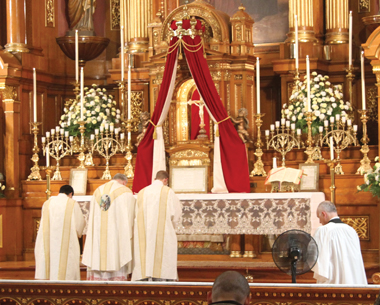Reclaim Beauty
Revitalize Through Architecture and Art

Revitalizing parishes with a transcendent focus begins with the liturgy. Hand-in-hand, sacred music also is a foundational part of the revitalization. On this essential base, the next step in the revitalization is the art and architecture.
Sacrosanctum Concilium, the Second Vatican Council’s dogmatic constitution on the sacred liturgy, stated that, for “centuries, she [the Church] has brought into existence a treasury of art which must be preserved with every care,” and “placing sacred images in churches so that they can be venerated by the faithful is to be maintained.”
More than once, Pope Emeritus Benedict XVI addressed this important area. As Cardinal Joseph Ratzinger, he observed in The Spirit of the Liturgy, “Images of beauty, in which the mystery of the invisible God becomes visible, are an essential part of Christian worship.”
Benedict was speaking of transcendence, which means going beyond the ordinary to give a taste of the eternal and the divine.
Transcendence is crucial for true liturgical art and architecture, said internationally known architect and author Duncan Stroik: “We’re ennobled, but we’re also small in comparison to God. The building sets the tone for what we are there for.”
As architectural historian Denis McNamara, assistant director at the Liturgical Institute of the University of St. Mary of the Lake/Mundelein Seminary, observed, “We see the order, radiance, color and light of heaven in beautiful marble, stained glass, silk and gold. Moreover, in icons, statues and murals, we see images of angels, saints and even the Trinity itself. In this sacramental understanding, God’s presence is mediated through art and architecture, and we are drawn to him through them.”
In revitalizing, some parishes start fresh; others refurbish or renovate. At St. John Cantius in Chicago, after Father Frank Phillips restored the beautiful liturgy, financial resources followed, allowing him to begin preserving and restoring the physical space and the existing art treasures.
“The Church is the greatest teacher of our faith because we learn so much from walking into a building,” Father Phillips said.
Father Phillips and artist Jed Gibbons designed the new wood inlaid flooring as a seamless part of the transcendent revitalization. The artistry and symbols begin with the heritage of Abraham and progress to the Passion and Resurrection — a timeline of Jesus’ life on earth and in eternity.
Similarly, the magnificent millennium monstrance was fashioned from parishioners’ donations of sterling silver, precious stones and gold and carries a multitude of symbols.
At the inner-city parish of St. Peter Church in Omaha, Neb., Father Damien Cook is also a great proponent of the sacred arts: “The music, art and architecture are invaluable and have to be reclaimed, and they have a power in the way Mass is celebrated.”
The parish raised the more than $3 million needed to restore its beauty. “It’s not all hearing, but also seeing and experiencing,” he said. “There is nothing better than to have a church, replete with symbolism in accord with mystical theology,” to preach in and to lift people’s souls heavenward, he said. Over and over he hears, “This feels like a church, Father.”
Architect Stroik confirms this benefit. “The church can actually make us think about beauty, God, creation, truths of the faith, the things we believe.”
Showing the beauty of transcendent revitalization is key, said Father Thomas Milota of Sts. Peter and Paul Catholic Church in Naperville, Ill. His striking 1927 Neo-Gothic Revival church had seen some renovation in 1985. More recent renovations restored a portion of the high altar in the suburban-Chicago church. Now, the plan is to restore decorative painting in the sanctuary.
Initially, some parishioners supported these efforts, while others opposed them. Then Father Milota began including photos of the area’s more decorative Gothic-Revival churches in the bulletins. As he recalled, “After they saw all these incredibly beautiful, decoratively painted churches, they said, ‘Wow! Our church can look like that?’”
Among several parishes building new edifices is St. Mary, Help of Christians, in Aiken, S.C. The parish outgrew its 1905 Gothic-Revival edifice, yet parishioners didn’t want to give up the old church. “They were drawn to its beauty,” said Father Gregory Wilson, the pastor.
While old St. Mary’s will still be used for daily and school Masses as well as weddings, parishioners now are already drawn to the new church building, as construction is well under way. “It’s being done in very traditional design, Renaissance style,” noted Father Wilson. “We wanted people to walk in and immediately know this is a Catholic church and know it’s beautiful.”
Joseph Pronechen is the
Register’s staff writer.
Image courtesy of St. John Cantius Flickr.

















